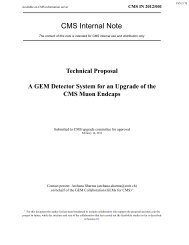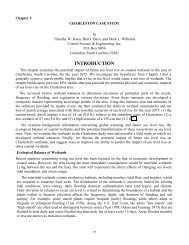A Displacement Metric for Finite Sets of Rigid Body Displacements
A Displacement Metric for Finite Sets of Rigid Body Displacements
A Displacement Metric for Finite Sets of Rigid Body Displacements
You also want an ePaper? Increase the reach of your titles
YUMPU automatically turns print PDFs into web optimized ePapers that Google loves.
F<br />
x<br />
the associated quaternions. The techniques presented here are<br />
based on the polar decomposition (PD) <strong>of</strong> the homogenous<br />
trans<strong>for</strong>m representation <strong>of</strong> the elements <strong>of</strong> SE(N) and the<br />
principal frame (PF) associated with the finite set <strong>of</strong> rigid body<br />
displacements. The mapping <strong>of</strong> the elements <strong>of</strong> the special<br />
Euclidean group SE(N-1) to SO(N) yields hyperdimensional<br />
rotations that approximate the rigid body displacements. A<br />
conceptual representation <strong>of</strong> the mapping <strong>of</strong> SE(N-1) to SO(N)<br />
is shown in Figure 1. Once the elements are mapped to SO(N)<br />
distances can then be evaluated by using a bi-invariant metric<br />
on SO(N). In the planar case the elements <strong>of</strong> SE(2) are mapped<br />
onto the SO(3) as shown in Figure 2. The resulting PD based<br />
projection metric on SE(N-1) is left invariant (i.e. independent<br />
<strong>of</strong> the choice <strong>of</strong> fixed frame F).<br />
METRIC ON SO(N)<br />
The distance between elements in SO(N) can be determined<br />
by using the metric suggested by Larochelle [11]. The distance<br />
between two elements [A1] and [A2] in SO(N) can be defined by<br />
using the Frobenius norm as follows,<br />
d = [I] − [A2][A1] T F<br />
FINITE SETS OF LOCATIONS<br />
Consider the case when a finite number <strong>of</strong> n displacements<br />
(n≥2) are given and we have to find the magnitude <strong>of</strong> these<br />
displacements. The displacements depend on the coordinate<br />
frame and the system <strong>of</strong> units chosen. In order to yield a left<br />
invariant metric we utilize a PF that is derived from a unit point<br />
y<br />
ψ<br />
M<br />
Figure 2. SE(2) to SO(3)<br />
(1)<br />
2<br />
1.5<br />
1<br />
0.5<br />
0<br />
−0.5<br />
−1<br />
F<br />
θ<br />
M3<br />
M<br />
φ<br />
M4<br />
M2<br />
M1<br />
ψ<br />
M5<br />
M6<br />
F<br />
PF<br />
M7<br />
−1.5 −1 −0.5 0 0.5 1 1.5 2<br />
M8<br />
M9<br />
Figure 3. Unit Point Mass Model<br />
mass model <strong>for</strong> a moving body as suggested by Larochelle [11].<br />
This is done to yield a metric that is independent <strong>of</strong> the geometry<br />
<strong>of</strong> the moving body. The center <strong>of</strong> mass and the principal axes<br />
frame are unique <strong>for</strong> the system and invariant with respect to<br />
both the choice <strong>of</strong> fixed coordinate frames as well as the system<br />
<strong>of</strong> units [12, 13].<br />
The procedure <strong>for</strong> determining the center <strong>of</strong> mass −→ c and<br />
the PF associated with the n prescribed locations is described<br />
2 Copyright c○ 2008 by ASME<br />
M10<br />
M11
















